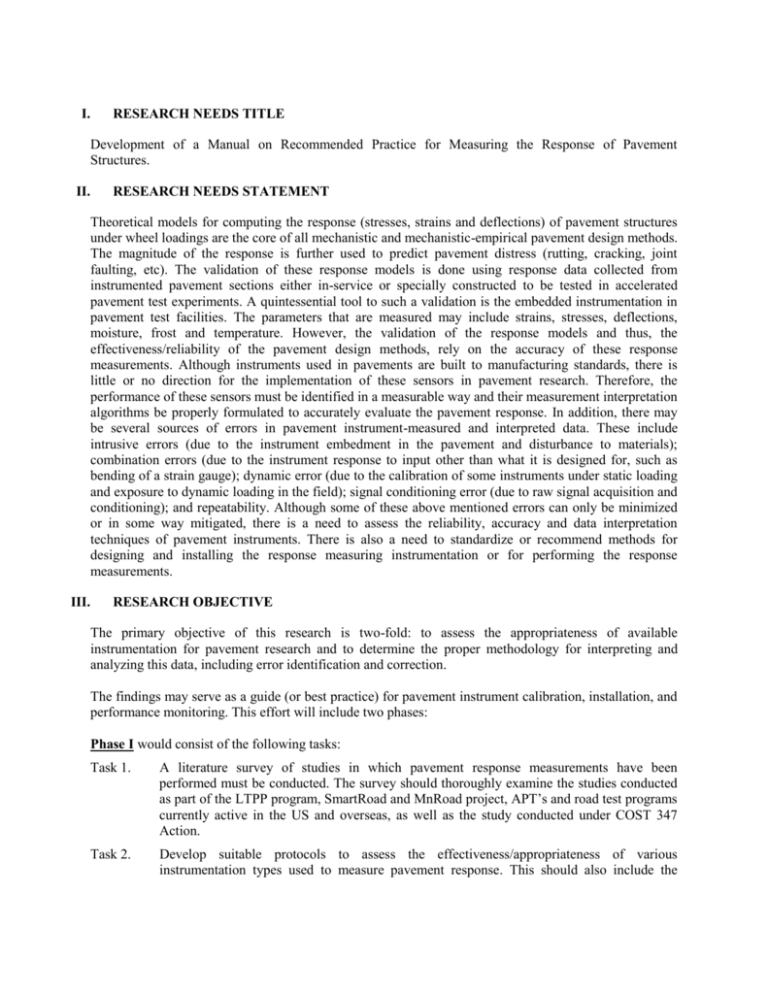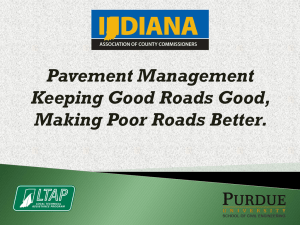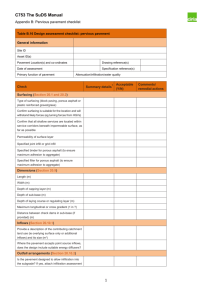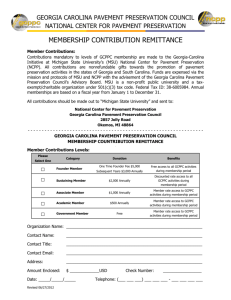Pavement Instrumentation RNS
advertisement

I. RESEARCH NEEDS TITLE Development of a Manual on Recommended Practice for Measuring the Response of Pavement Structures. II. RESEARCH NEEDS STATEMENT Theoretical models for computing the response (stresses, strains and deflections) of pavement structures under wheel loadings are the core of all mechanistic and mechanistic-empirical pavement design methods. The magnitude of the response is further used to predict pavement distress (rutting, cracking, joint faulting, etc). The validation of these response models is done using response data collected from instrumented pavement sections either in-service or specially constructed to be tested in accelerated pavement test experiments. A quintessential tool to such a validation is the embedded instrumentation in pavement test facilities. The parameters that are measured may include strains, stresses, deflections, moisture, frost and temperature. However, the validation of the response models and thus, the effectiveness/reliability of the pavement design methods, rely on the accuracy of these response measurements. Although instruments used in pavements are built to manufacturing standards, there is little or no direction for the implementation of these sensors in pavement research. Therefore, the performance of these sensors must be identified in a measurable way and their measurement interpretation algorithms be properly formulated to accurately evaluate the pavement response. In addition, there may be several sources of errors in pavement instrument-measured and interpreted data. These include intrusive errors (due to the instrument embedment in the pavement and disturbance to materials); combination errors (due to the instrument response to input other than what it is designed for, such as bending of a strain gauge); dynamic error (due to the calibration of some instruments under static loading and exposure to dynamic loading in the field); signal conditioning error (due to raw signal acquisition and conditioning); and repeatability. Although some of these above mentioned errors can only be minimized or in some way mitigated, there is a need to assess the reliability, accuracy and data interpretation techniques of pavement instruments. There is also a need to standardize or recommend methods for designing and installing the response measuring instrumentation or for performing the response measurements. III. RESEARCH OBJECTIVE The primary objective of this research is two-fold: to assess the appropriateness of available instrumentation for pavement research and to determine the proper methodology for interpreting and analyzing this data, including error identification and correction. The findings may serve as a guide (or best practice) for pavement instrument calibration, installation, and performance monitoring. This effort will include two phases: Phase I would consist of the following tasks: Task 1. A literature survey of studies in which pavement response measurements have been performed must be conducted. The survey should thoroughly examine the studies conducted as part of the LTPP program, SmartRoad and MnRoad project, APT’s and road test programs currently active in the US and overseas, as well as the study conducted under COST 347 Action. Task 2. Develop suitable protocols to assess the effectiveness/appropriateness of various instrumentation types used to measure pavement response. This should also include the development of appropriate data analysis methodologies for the subsequent instrumentation measurements. Task 3. Task 4. Draft plans for the instrumentation/verification of the developed methodologies/protocols. This also includes drafting a plan for an experiment to be conducted in Phase II, in which one flexible and one rigid pavement structure (both including substructure) will be instrumented with sensors and responses will be measured. The experiment will aim to: Evaluate the applicability of sensors currently marketed in the US. Compare the efficiency and effectiveness of several installation methods Compare the quality and corresponding costs of data acquisition systems Evaluate the overall effectiveness of pavement response measurements Prepare and submit an interim report documenting in detail the work conducted in Tasks 1, 2 and 3, and the plans drafted as part of the work in Task 3. Phase 2 would consist of the following tasks: Task 5. Conduct the experiment designed in Task 3. Task 6. Analyze the data obtained in the experiment conducted in Task 4 and draft a manual for the design and installation of pavement response instrumentation, as well as for performing the response measurements Task 7. Draft a final report presenting in detail the entire research work conducted. IV. V. ESTIMATE OF FUNDING AND RESEARCH PERIOD Recommended Funding: Phase 1: Approximately $80,000. Phase 2: Approximately $320,000. Research Period: Total Duration: 24 months URGENCY, PAYOFF POTENTIAL, AND IMPLEMENTATION The results of this much needed research effort will be of significant benefit to transportation agencies and the pavement community. The findings will provide for a more appropriate interpretation and assessment of substantial instrumentation data, now require to fully understand the mechanics of the pavement structure’s response to loading. This research is beneficial to all state DOT’s because it will provide a recommended practice for measuring pavement response. This will provide valuable and timely help to the states that perform pavement response measurements as part of the local calibration of the mechanistic-empirical design methods for pavement structures. It will also significantly help the fourteen accelerated pavement testing programs currently active in the United States; they may revise the practice and replace the instrumentation and equipment (sensors, data acquisition systems) currently used. The anticipated product would be a manual for the design and installation of pavement response instrumentation, as well as methodologies for the performing the response measurements and data interpretation; as no such manual exists currently. The manual and final report of this research project should be distributed to all state DOTs, FHWA and AASHTO. No institutional or political barriers to implementation of the anticipated research products are anticipated.





